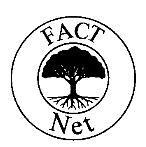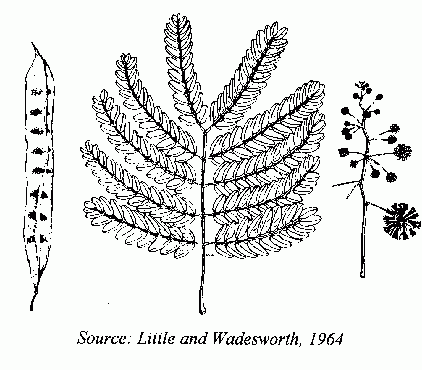Albizia procera – white siris for reforestation and agroforestry

Albizia procera is a large, fast-growing tree that occurs on many different sites. Like other Asian Albizias, it occurs in forests and savanna woodlands, but prefers moister sites than its relatives. This species provides wood for a variety of purposes, nutritious fodder for livestock and shade for tea plantations. It is an important reforestation and agroforestry species. It is commonly called white siris or tall albizia and has many regional names.

Botany
Albizia procera (Roxb.) Benth. is usually 60-70 cm in diameter and 25 meters in height. Troup (1921) reports trees as large as 95 cm in diameter and 36 meters in height. Mature individuals are characterized by a tall, clear, erect, sometimes curved trunk and large branches which form a thin, spreading crown. The bark is nearly smooth, whitish to light-greenish gray or light-brown. It exfoliates in thin flakes with red undersides (Troup 1921). Lateral roots are wide-spreading and the taproot stout. The bipinnate leaves, reddish when juvenile, mature to a length of 12-25 cm; leaflets are 2-4 cm long and 8-16 mm wide.
Flowering varies by geographic location; January to March in Indonesia (Djogo 1992), June to September in India, (Troup 1921) September in Manila (Hensleigh and Holaway 1988) and August to October in Puerto Rico (Parrotta 1987). Flowers are borne on racemes 8-25 cm long near the end of a twig. Numerous greenish-yellow flowers form whitish heads 20-24 mm in diameter. Individual flowers, 6-7 mm long, have long white threadlike spreading stamens about 10 mm long (Little and Wadsworth 1964). The reddish-brown flat pods, 10-20 cm long and 18-25 cm wide, are produced in large numbers and ripen 3-5 months after flowering. The mature brown pods, each containing 6-12 seeds, usually remain on the tree until the twig bearing the pods is shed (Troup 1921, Little and Wadsworth 1964). The natural regeneration of white siris is generally good. Following the beginning of the rainy season large numbers of seedlings are common near mature trees. Seedlings, saplings and mature trees coppice vigorously from stumps and roots (Parrotta 1987).
Ecology
White siris is a component of tropical and subtropical moist and wet forest types where rainfall is 1000-5000 mm/yr. It develops best when rainfall is above 2500 mm/yr. Growing to elevations of 1200 meters, this species is also common on moisture savannas and swamp forests. In its natural habitat, maximum temperatures vary from 37-46° C and minimum temperatures from 1-18° C. Once established white siris is drought tolerant. It is susceptible to frost (Troup 1921, Djogo 1992).
Like many nitrogen fixing trees, white siris survives on a variety of soils. It grows best on moist alluvial soils, well-drained loams or clay soils (Brandis 1906, Venkataramany 1968). Its ability to grow on dry, sandy, stony, and shallow soils makes it a useful species for reforestation of difficult sites. Good survival and rapid early growth have been reported in afforestation trials on both saline and alkaline soils (Ghosh 1976). It does not tolerate suppression, but will survive moderate shade between the seedling and small tree stage (Venkataramany 1968).
In India, white siris is dominant to co-dominant in mixed deciduous forest; or found as scattered individuals or in small groups in savanna woodlands (Benthall 1933, Bor 1953). In Puerto Rico, white siris is an aggressive pioneer, forming pure stands on abandoned farms and other disturbed sites. It is also common in pastures at elevations below 600 meters, including areas receiving as little as 800 mm of annual rainfall.
Distribution
The native range of A. procera is South and Southeast Asia between latitudes 30 degrees N to 15 degrees S. The tree occurs naturally in India, Nepal, Bangladesh, the Andaman Islands, Burma, southern China, Laos, Thailand, Cambodia, Vietnam, Malaysia, the Philippines, Indonesia, Papua New Guinea, Melanesia and northern Australia (Nielsen 1979). It is naturalized in the Virgin Islands and Puerto Rico.
Uses
Agroforestry. Natural regeneration of A. procera is often encouraged on farms to provide small timber, fuelwood, charcoal, fodder or shade. Seedlings are planted in family forests or home gardens for the same purposes. Albizia procera can be cultivated as shade for tea plantations. However, Albizia odoratissima is preferred for this purpose because of its rapid early growth, fuller crown and resistance to red spidermites. The protein-rich fodder of A. procera is eaten by cattle, buffaloes, goats, camels and elephants in South Asia and the Philippines. However, the fodder is not utilized in Nusa Tenggara, Indonesia.
Wood. Durable, strong and resistant to termites, the wood is light- to chocolate-brown with light and dark bands. It is difficult to saw due to interlocking grain and has a specific gravity of 0.6-0.9. The wood is used to produce wheels, carts, boats, furniture, flooring, posts, agriculture implements, boxes and carvings. This species is considered a promising source of pulp for high-quality paper (Parrotta 1987).
Other Uses. Trees are often planted for shade or beautification along roads. Albizia procera is commonly used in traditional medicines (Venkalarammany 1968). The bark contains tannins and a reddish gum. Also, it can be used to make a poison. The leaves are used to treat ulcers and have insecticidal properties (Parrotta 1987). In the Philippines, the cooked leaves are eaten as a vegetable (Hensleigh and Holaway 1988).
Silviculture
Propagation. Seeds are small, greenish-brown, elliptical to round, flat and have a hard, smooth seedcoat. There are 20,000-24,000 seeds per kilogram (Roshetko 1997). Insect damage to seed is common in Indonesia (Djogo 1992) but not in India (Troup 1921). Fresh seed germinates readily without treatment (Parrotta 1987). Clean seed can be stored at room temperature for 10 months with minimal loss of viability (Roshetko 1997). Seed that has been stored should be treated before sowing; cut through the seedcoat with a knife or file, or soak seeds in boiled water for 3 minutes. After either treatment, soak seed in cool water for 12-24 hours and sow immediately (Roshetko 1997).
In the nursery, seed should be sown in containers or beds. Seedling growth is favored by loose soil, sufficient soil moisture, full sunlight and the absence of weeds. Healthy seedlings produce a thick, long taproot. After two months in the nursery containerized or bare-root seedlings should be transplanted to the field. Direct sowing of white siris is successful given abundant soil moisture and regular weed control (Troup 1921). Propagation is also possible by stem or root cutting and stump sprouts. Plantations should be weeded twice in the first year and once during the second. During weeding, soil should not be unduly exposed; only weeds directly interfering with seedlings should be removed (Venkataramany 1968).
Growth and Management. In Bangladesh, plantation trees have reached heights of 0.3 and 4.5 m in 1 and 5 years. In Burma 6-year-old trees average heights and diameters of 12.8 m and 16 cm, respectively. In Indonesia, 17-year-old trees average heights and diameters of 24.3 m and 22.4 cm, respectively. Total standing volumes of 87 m³/ha have been reported in 8-year-old plantations in Burma and of 151 m³/ha in 17-year-old plantations in Indonesia. Natural forests are managed for timber production by coppicing on a 40-year rotation. Fuelwood plantations are managed on a 20-year rotation (Venkataramany 1968).
Symbiosis
Albizia procera forms symbiotic association with Rhizobium bacteria enabling it to fix nitrogen and thrive on infertile soils. The application of phosphorus fertilizer can improve nodulation and nitrogen fixation, particularly on infertile soils.
Limitations
Because of its aggressive growth white siris may be a potential weed. This is particularly true in the Caribbean where white siris grows faster than many native species.
References
Benthall, A.P. 1933. The trees of Calcutta and its neighborhood. Thacker Spink and Co., Calcutta, India. 513 p.
Bor, N.L. 1953. Manual of Indian forest botany. Oxford University Press, London, UK. 441 p.
Brandis, D. 1906. Indian trees. Bishen Singh Mahendra Pal Singh, Dehra Dun, India.
Djogo, A.P.Y. 1992. The possibilities of using local drought-resistant multipupose tree species as alternatives to lamtoro (Leucaena leucocephala) for agroforestry and social forestry in West Timor. Working Paper No. 32. EAPI, East West Center, Honolulu, Hawaii, USA. 41 p.
Ghosh, R.C. 1976. Afforestation problems of saline and alkaline soils in India. Van Vigyan 14(1): 1-17.
Hensleigh, T.E. and B.K. Holaway. 1988. Agroforestry species for the Philippines. Washington DC: US Peace Corps, 404 p.
Little, E.L., F.H. Wadsworth. 1964. Common trees of Puerto Rico and the Virgin Islands. Agric. Handbook 249. US Department of Agriculture, Washington DC. 548 p.
Nielsen, I. 1979. Notes on the genus Albizia Durazz. (Leguminosae-Mimosaceace) in mainland S.E. Asia. Adansonia 19(2): 199-229.
Parrotta, J.A. 1987. Albizia procera (Roxb.)Benth. Silvics of Forest Trees of the American Tropics. Rio Piedras, Puerto Rico USA: USDA Forest Service, International Institute of Tropical Forestry. 4 p.
Roshetko, J.M. 1997. Seed treatment for Albizia species. In: N.Q. Zabala (ed.) Albizia & Paraserianthesis. Proceedings of an international workshop. Morrilton, Arkansas, USA: Winrock International, in press.
Troup, R.S. 1921. The silviculture of Indian trees. Clarendon Press, Oxford, UK. 1195 p.
Venkataramany, P. 1968. Silvicuture of genus Albizia and species. Silviculture of Indian trees., No. 22. Government of India, Delhi, India. 54 p.
Written by John A. Parrotta¹ and James M. Roshetko². ¹Research Forester, USDA Forest Service, International Institute of Tropical Forestry, Rio Piedras, PR 00928-4984, USA and ²Program Officer, Winrock International.
